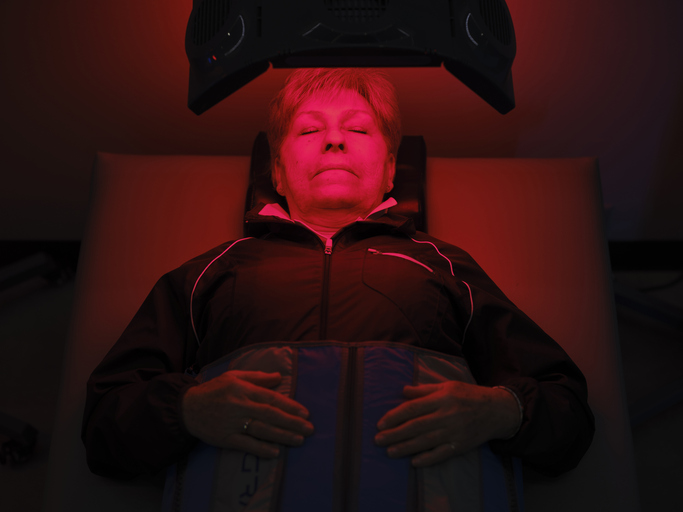Red Light May Improve Blood Sugar Levels by Optimizing ATP Production

By Joy Stephenson-Laws, J.D., Founder
Have you thought about your mitochondria lately? Didn’t think so, but it’s super important. Almost every cell in our bodies has several thousand mitochondria. Often called the cell’s powerhouse, they process oxygen and help convert food into energy. More specifically, mitochondria help metabolize and break down carbohydrates and fatty acids. They make 90 percent of the energy our bodies need to function properly. So to say that they have an important job in keeping us healthy is an understatement. Specifically speaking, this energy I am referring to is called (adenosine triphosphate) ATP.
“Because the body cannot store ATP, the mitochondria must function consistently all the time. At any given time there are about 250 g of ATP in the cells. This represents about 4.25 watts, the equivalent of the energy in an AA battery. Every day, a healthy person produces a remarkable 1200 watts! Because the brain uses 70% of ATP, this helps explain the strong correlation between mitochondrial dysfunction and neurodegeneration,” according to a report published by the National Institutes of Health (NIH).
This report mentions that the average cell uses 10 billion ATP per day!
“The mitochondria are especially susceptible to nutrient deficiencies, environmental toxins, and oxidative damage.”

There also appears to be a link between mitochondrial function/ATP production and blood glucose levels. This is a big deal, because diabetes (particularly type 2) is a major health issue in this country. To give some perspective:
- Around 38 million Americans have diabetes, about 90 to 95 percent of them have type 2 diabetes (Centers for Disease Control and Prevention (CDC)).
- Around 98 million U.S. adults have prediabetes, and eight in 10 of them don’t even know that they have it (CDC).
- Diabetes is the eighth leading cause of death in the United States (CDC).
Optimizing ATP production could be key in maintaining healthy blood glucose levels, and one of the ways to improve ATP production may be being proactive about the type of light you are exposed to. A recent study found evidence suggesting that red light can reduce blood glucose levels.
If you are a regular reader of pH blogs, you have likely read about red light therapy (RLT). It is a form of low-level laser (light) therapy (LLLT) and is offered in many medical office settings. Think of it as like a healthy tanning bed. During a session, the light delivers wavelengths of natural red and near infrared light. It’s like the wavelengths you get from sunlight without the harmful UV rays.
The study, conducted by researchers from City, University of London and University College London, took 30 healthy individuals (so, no diabetes or other existing health issues) and randomly assigned them to one of two groups. One group was exposed to 15 minutes of 670 nanometers (nm) of red light, and the other group (the placebo group) was not. The participants were then instructed to complete an oral glucose tolerance test (which involves drinking glucose dissolved in water). They had to record their blood glucose levels every 15 minutes over a period of two hours.

“People who received red light exposure 45 minutes prior to drinking glucose exhibited a reduced peak blood glucose level and reduced total blood glucose during the two hours,” according to this report that discusses the study.
“It is clear that light affects the way mitochondria function and this impacts our bodies at a cellular and physiological level. Our study has shown that we can use a single, 15-minute exposure to red light to reduce blood sugar levels after eating,” said Lead Study Author Dr. Powner, according to the report.
Red light can actually increase the production of ATP, and this reduces blood glucose. What a great example of biohacking for disease prevention and longevity.
Be mindful of blue light.In order to really appreciate and take advantage of the red light, you have to understand and be aware of blue light.
Sunlight is the main source of natural blue light (short wavelength, high energy). Think of blue light as your “wake up and go” type of light. Blue light is important for mental alertness and performance. If coffee were a light, blue light would be it. This type of light tells our bodies to slow down the production of melatonin (the sleep hormone that our bodies produce). But get this. Serotonin (a neurotransmitter and hormone that acts as a mood stabilizer) is a precursor to melatonin, and the body makes serotonin from exposure to blue light. So what this essentially means is that you need blue light to make serotonin and then later make melatonin. This is why, along with getting vitamin D, getting exposure to sunlight daily is so key to our overall health and wellness.
The problem is most of us are exposed to way too much artificial blue light. After the sun has set and it gets dark outside, we don’t really need blue light for the purpose of regulating our circadian rhythm (the inner 24-hour cycle that governs literally all our bodily functions from when we get up and go to sleep, when our metabolism is most active and when various organ systems work at their peak efficiency). Melatonin responds to darkness. When it gets dark outside, our brain receives the signal to start producing melatonin. Most of us are exposed to very high amounts of artificial blue light throughout the day, including when it starts to get dark outside, via smartphones, computers, tablets, televisions, LED (light emitting diode) lights and fluorescent lights.
This not only has a negative impact on the circadian rhythm but may also disrupt the balancing of blood glucose.
Professor Glen Jeffery, one of the authors of the study, said, “Sunlight has a balance between red and blue, but we now live in a world where blue light is dominant because although we do not see it, LED lights are dominant in blue and have almost no red in them. This reduces mitochondrial function and ATP production.”
Ideally, we need to prevent ourselves from living in a blue dominant world.
“Hence our internal environments are red-starved. Long-term exposure to blue light is potentially toxic without red. Blue light on its own impacts badly on physiology and can drive disrupted blood sugars that may in the long run contribute to diabetes and undermine health spans,” said Professor Jeffery.
This is why we should really consider red light therapy along with minimizing exposure to artificial blue light during the evenings. Know that red light can impact in a positive way two of your body’s most important processes: ATP production and the circadian rhythm. To get even more of an understanding on this, check out Bright Light Therapy May Help Diminish Multiple Sclerosis Fatigue.
To learn more about red light therapy and book an appointment for treatment, click here if you are in San Diego and here if you are in the Los Angeles area.

Finally, keep in mind that diabetes prevention and management as well as good mitochondrial function heavily depend on leading an overall healthy lifestyle which includes a nutrient-rich diet and regular exercise. Getting routine nutrient tests is always good to determine any nutrient imbalances. Most of us have them, but the good news is we can usually resolve imbalances through diet changes and/or by taking quality supplements per the recommendation of a competent healthcare professional.
Enjoy your healthy life!
Disclaimer: This article is not intended to provide medical advice. Please consult with your doctor or another competent healthcare practitioner to get specific medical advice for your situation.
The pH professional health care team includes recognized experts from a variety of health care and related disciplines, including physicians, attorneys, nutritionists, nurses, and certified fitness instructors. This team also includes the members of the pH Medical Advisory Board, which constantly monitors all pH programs, products, and services. To learn more about the pH Medical Advisory Board, click here.







